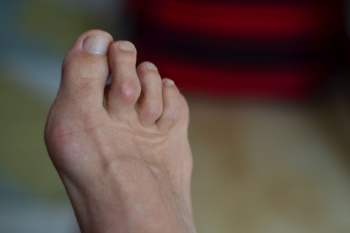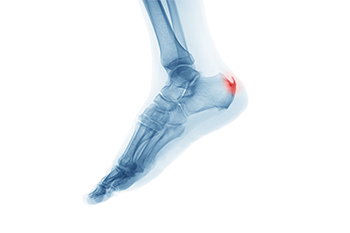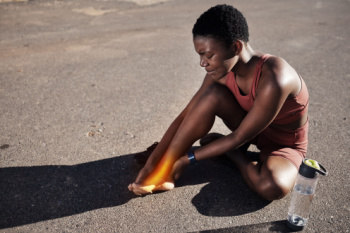Items filtered by date: May 2025
Wounds That Don't Heal Need to Be Checked
Common Causes of Ankle Injuries in Baseball

Ankle injuries are a frequent concern in baseball due to the dynamic and fast-paced nature of the game. Players often experience sprains or strains as a result of rapid direction changes and high-impact movements. Running at full speed and sliding into bases can place intense stress on the ankle joints, especially when contact with the base is awkward or mistimed. Uneven playing surfaces increase the risk of rolling the ankle during sprints or fielding. Quick lateral movements and sudden stops while fielding or chasing a ball also contribute to ankle strain. Additionally, stealing bases demands explosive acceleration and abrupt sliding, which can lead to twists or falls. If you have sustained a foot or ankle injury while playing baseball, it is suggested that you consult a podiatrist who can offer effective treatment solutions, allowing you to return to this popular sport as soon as possible.
Sports related foot and ankle injuries require proper treatment before players can go back to their regular routines. For more information, contact Brandon M. Zuklie, DPM of New Jersey. Our doctor can provide the care you need to keep you pain-free and on your feet.
Sports Related Foot and Ankle Injuries
Foot and ankle injuries are a common occurrence when it comes to athletes of any sport. While many athletes dismiss the initial aches and pains, the truth is that ignoring potential foot and ankle injuries can lead to serious problems. As athletes continue to place pressure and strain the area further, a mild injury can turn into something as serious as a rupture and may lead to a permanent disability. There are many factors that contribute to sports related foot and ankle injuries, which include failure to warm up properly, not providing support or wearing bad footwear. Common injuries and conditions athletes face, including:
- Plantar Fasciitis
- Achilles Tendinitis
- Achilles Tendon Rupture
- Ankle Sprains
Sports related injuries are commonly treated using the RICE method. This includes rest, applying ice to the injured area, compression and elevating the ankle. More serious sprains and injuries may require surgery, which could include arthroscopic and reconstructive surgery. Rehabilitation and therapy may also be required in order to get any recovering athlete to become fully functional again. Any unusual aches and pains an athlete sustains must be evaluated by a licensed, reputable medical professional.
If you have any questions please contact our offices located in Piscataway, Jamesburg, and Branchburg, NJ . We offer the newest diagnostic and treatment technologies for all your foot and ankle needs.
Choosing the Right Shoes for Hammertoes

Hammertoes cause one or more toes to bend unnaturally at the middle joint, leading to pain, pressure, and difficulty finding comfortable shoes. Wearing tight or narrow footwear can make the problem worse by rubbing against the raised joints and crowding the toes. The right shoes can help relieve discomfort and slow the progression of the condition. Look for styles with a wide toe box, soft uppers, and plenty of depth to reduce friction and allow room for the toes to lie flat. Avoid high heels or pointed toes, which place extra strain on the front of the foot. In some cases, custom orthotics or padding can add support and prevent rubbing. Wearing comfortable, supportive footwear makes a big difference for those living with hammertoes. If shoes continue to cause pain or your toes become more rigid, it is suggested you see a podiatrist for treatment and further guidance on appropriate footwear.
Hammertoe
Hammertoes can be a painful condition to live with. For more information, contact Brandon M. Zuklie, DPM from New Jersey. Our doctor will answer any of your foot- and ankle-related questions.
Hammertoe is a foot deformity that affects the joints of the second, third, fourth, or fifth toes of your feet. It is a painful foot condition in which these toes curl and arch up, which can often lead to pain when wearing footwear.
Symptoms
- Pain in the affected toes
- Development of corns or calluses due to friction
- Inflammation
- Redness
- Contracture of the toes
Causes
Genetics – People who are genetically predisposed to hammertoe are often more susceptible
Arthritis – Because arthritis affects the joints in your toes, further deformities stemming from arthritis can occur
Trauma – Direct trauma to the toes could potentially lead to hammertoe
Ill-fitting shoes – Undue pressure on the front of the toes from ill-fitting shoes can potentially lead to the development of hammertoe
Treatment
Orthotics – Custom made inserts can be used to help relieve pressure placed on the toes and therefore relieve some of the pain associated with it
Medications – Oral medications such as anti-inflammatories or NSAIDs could be used to treat the pain and inflammation hammertoes causes. Injections of corticosteroids are also sometimes used
Surgery – In more severe cases where the hammertoes have become more rigid, foot surgery is a potential option
If you have any questions, please feel free to contact our offices located in Piscataway, Jamesburg, and Branchburg, NJ . We offer the newest diagnostic and treatment technologies for all your foot care needs.
What Is a Heel Spur?

A heel spur is a bony growth that develops on the underside of the heel bone, often where the plantar fascia attaches. It typically forms over time as a response to ongoing stress or pressure on the foot. One of the main contributing factors is aging, as the tissues naturally lose elasticity and strength. Abnormal stress from repetitive activities, poor foot function, or walking patterns can place excessive strain on the heel. Carrying extra weight increases the load on the feet, which can lead to small tears in the plantar fascia. These micro-tears trigger inflammation and can encourage calcium deposits to build up, forming a spur. If you have heel pain, it is suggested that you schedule an appointment with a podiatrist who can accurately diagnose and treat heel spurs.
Heel spurs can be incredibly painful and sometimes may make you unable to participate in physical activities. To get medical care for your heel spurs, contact Brandon M. Zuklie, DPM from New Jersey. Our doctor will do everything possible to treat your condition.
Heels Spurs
Heel spurs are formed by calcium deposits on the back of the foot where the heel is. This can also be caused by small fragments of bone breaking off one section of the foot, attaching onto the back of the foot. Heel spurs can also be bone growth on the back of the foot and may grow in the direction of the arch of the foot.
Older individuals usually suffer from heel spurs and pain sometimes intensifies with age. One of the main condition's spurs are related to is plantar fasciitis.
Pain
The pain associated with spurs is often because of weight placed on the feet. When someone is walking, their entire weight is concentrated on the feet. Bone spurs then have the tendency to affect other bones and tissues around the foot. As the pain continues, the feet will become tender and sensitive over time.
Treatments
There are many ways to treat heel spurs. If one is suffering from heel spurs in conjunction with pain, there are several methods for healing. Medication, surgery, and herbal care are some options.
If you have any questions, please feel free to contact our offices located in Piscataway, Jamesburg, and Branchburg, NJ . We offer the newest diagnostic and treatment technologies for all your foot care needs.
When Foot Pain Should Not Be Ignored

Foot pain is often dismissed as temporary, but lingering discomfort may signal a deeper problem. Soaking your feet and gently massaging sore areas can offer relief, but persistent pain requires more than home remedies. Simple movements like ankle circles and toe stretches can ease stiffness and improve mobility. Wearing different shoes throughout the week helps reduce stress on certain areas of the foot, allowing tissues to recover. Pain may come from overuse, wearing improper footwear, or hidden conditions such as tendon injuries or nerve issues. Left untreated, these problems can grow worse, making walking difficult and limiting daily activity. Paying attention to what your feet are telling you is key to staying mobile and pain-free. If you have consistent foot pain or if symptoms seem to worsen, it is suggested that you see a podiatrist for an accurate diagnosis and appropriate treatment.
Foot Pain
Foot pain can be extremely painful and debilitating. If you have a foot pain, consult with Brandon M. Zuklie, DPM from New Jersey. Our doctor will assess your condition and provide you with quality foot and ankle treatment.
Causes
Foot pain is a very broad condition that could be caused by one or more ailments. The most common include:
- Bunions
- Hammertoes
- Plantar Fasciitis
- Bone Spurs
- Corns
- Tarsal Tunnel Syndrome
- Ingrown Toenails
- Arthritis (such as Gout, Rheumatoid, and Osteoarthritis)
- Flat Feet
- Injury (from stress fractures, broken toe, foot, ankle, Achilles tendon ruptures, and sprains)
- And more
Diagnosis
To figure out the cause of foot pain, podiatrists utilize several different methods. This can range from simple visual inspections and sensation tests to X-rays and MRI scans. Prior medical history, family medical history, and any recent physical traumatic events will all be taken into consideration for a proper diagnosis.
Treatment
Treatment depends upon the cause of the foot pain. Whether it is resting, staying off the foot, or having surgery; podiatrists have a number of treatment options available for foot pain.
If you have any questions, please feel free to contact our offices located in Piscataway, Jamesburg, and Branchburg, NJ . We offer the newest diagnostic and treatment technologies for all your foot care needs.

